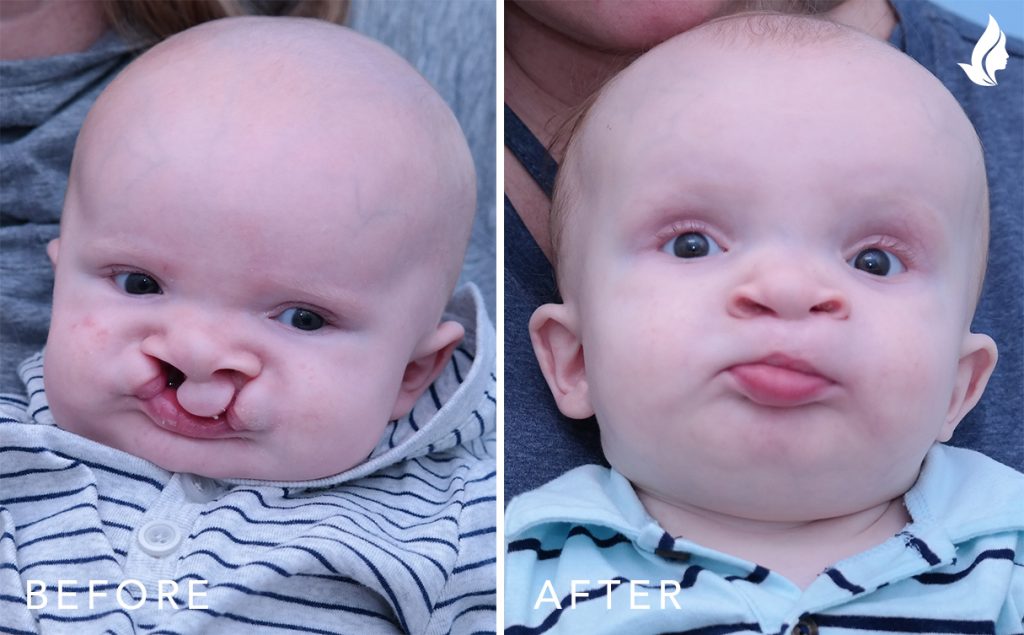There is no denying the power and symbolism of a smile. A wide and beaming grin can radiate health, vitality and friendliness. Our smile reflects how we feel and is an integral way in which we express ourselves. So, imagine what it must feel like to have your ability to smile disrupted by a facial abnormality such as a cleft lip or palate. Or, the despair a parent must feel when their child is born with this condition. As one of the most common birth defects in the United States, 1 in 750 births results in a cleft lip or palate each year. Luckily, there are dedicated surgeons who devote both their skill and compassion to children with cleft lip and palette and the families who love them.
“We were devastated when an ultrasound identified that Kayley may be born with a cleft lip,” shares Susan, a 36-year-old mother of two from Woodbury, Minnesota. “As parents, we weren’t sure how to navigate a child through something like this or even where to start researching what corrective surgeries we should be considering for her,” she continues. “Luckily, our OB/GYN referred us to Dr. Tolan and said that he is one of the Midwest’s leading physicians in performing cleft lip and palate surgeries on children,” Susan says smiling.
In Susan’s daughter, Claire’s case, the diagnosis of cleft lip or palate is commonly made during an ultrasound administered during pregnancy. As a child grows within the womb, its facial features grow separately and eventually conjoin. In the case of a cleft, these bones do not grow together. A cleft lip or palate is the most common craniofacial abnormality a baby can be born with.
A Cleft Lip may range from a small, little notch in the upper lip, to a complete separation of the upper lip that extends into the nose. It may affect one side of the face, or extend to both sides of the mouth. In certain cases, the cleft may also affect the entire gum line of a child where the teeth come through.
A Cleft Palate is identified as a gap on the roof of the mouth. The back of your mouth, towards your throat, is called the soft palate. The area that extends to the front of the mouth towards your teeth is the hard palate. A cleft can affect one or both of these areas.
“The cause of isolated cleft lip and cleft palate is unknown, though there can be an inherited component,” explains Dr. Christopher Tolan, Facial Plastic Surgeon, who is also an active member of the Cleft Lip and Palate panel at St. Paul Children’s Hospital and Clinics. “I explain to parents that no, it is not their fault or because of something they did or didn’t do,” he shares, encouragingly. “At this time, researchers believe that is may be a combination of both genetic and environmental factors.”
Dr. Christopher Tolan is a Midwest leader in the treatment of cleft lip and palate congenital deformities. He has traveled with the medical missions Love Without Boundaries (LWB), Children’s Surgery International (CSI), and Operation Hope; all volunteer organizations dedicated to providing surgical management for children and adults who have cleft lip and palate congenital malformations. To date, he has performed hundreds of cleft lip and cleft palate repairs on children.
“One of the first steps of action we take with cleft surgeries, is to lay out a staged and progressive approach to when and how surgeries will happen,” shares Dr. Tolan. “As you know, children grow rapidly and we need to time the surgeries to either wait for growth, or take advantage of it,” he explains. “In the first few weeks of a child’s life, we start treating cleft lip with presurgical orthopedics, or Nasoglveolar Molding to help improve alignment of the lip, nose and palate. This is generally continued for 12 to 16 weeks. Repair of the palate, on the other hand, is usually delayed until 9 to 12 months of age. It is also not unusual for children to undergo intermediate procedures in an effort to restore a more normalized appearance.”
They say it takes a village to raise a child and it definitely takes a team of diversified medical specialists to effectively treat and repair a cleft lip or palate. A multidisciplinary cleft team is generally assembled that may be comprised of speech pathologists, audiologists, dentists, orthodontists, oral surgeons and beyond. Teams, like Dr. Tolan’s surgical staff, work directly with a child’s cleft team to ensure the best, and most comprehensive results for a child with cleft lip or palate. The end goal is never just to repair the cleft, but to also improve a child’s overall quality of life.
“Dr. Tolan’s team literally became a part of our family during Kayley’s course of surgeries to repair her cleft lip,” says Susan. “They were with us through every up and down and each small victory,” she continues. “To be able to entrust your child to such a caring team at such a stressful time is just priceless. I will never forget the day when we all got to witness Kayley truly smiling for the first time with a fully repaired upper lip. I am so thankful for the quality of care our entire family received from Midwest Facial Plastics!”
Do you have further questions about Cleft Lip or Cleft Palate Repair at Midwest Facial Plastic Surgery? Schedule a consultation with Dr. Christopher Tolan by calling (651) 632-9700

